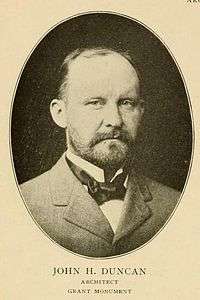John H. Duncan
John Hemenway Duncan (January 21, 1854[1] – October 18, 1929[2]) was an American architect.

Life and career
Duncan was the designer of the Wolcott Hotel. One of the most famous architects in the United States at the turn of the 20th century, his popularity rose after being selected as the architect of what is now Grant's Tomb,[3] another "reconstruction" of the Mausoleum of Halicarnassus (Greek Ionia).[4]
Another of Duncan's most famous works is the Soldiers' and Sailors' Memorial Arch in Grand Army Plaza in Brooklyn New York, often referred to as Brooklyn's version of the Arc de Triomphe.[5]
Duncan also contributed townhouses on Manhattan's Upper East side. One marvelous example is 21 E 84th Street (with its neighbors, 1132 and 1134 Madison Avenue), still intact today with much of the original interior and exterior. "A brick and terra-cotta terrace (English-style grouping of jointly designed townhouses), now sullied by unhappy storefronts on the avenue. But look up at the frieze".
In 1889, Duncan designed a five-story limestone mansion for Philip Lehman at 7 West 54th Street, which is now known as the "Philip Lehman Masion" and designated as a New York landmark in 1981.[6]
He also designed Walhall, a "great estate" in Greenwich, Connecticut. Although the main house no longer exists, an outbuilding intended eventually for the superintendent still exists and is a private residence today.[7]
References
- "John Hemingway Duncan (1854-1929) - Find A Grave..." www.findagrave.com. Retrieved 2018-07-03.
- Bondi, Victor (1996). American Decades: 1920-1929. Gale Research. p. 188. ISBN 0810357240.
- Dolkart, Andrew; Postal, Matthew A. (2003). Guide to New York City Landmarks. John Wiley and Sons. p. 196. ISBN 0-471-36900-4.CS1 maint: uses authors parameter (link)
- Dolkart, Andrew; Postal, Matthew A. (2003). Guide to New York City Landmarks. John Wiley and Sons. p. 197. ISBN 0-471-36900-4.CS1 maint: uses authors parameter (link)
- Reynolds, Donald Martin (1994). The Architecture of New York City: Histories and Views of Important Structures, Sites, and Symbols. Rev. Ed. New York: John Wiley & Sons. pp. 312–313. ISBN 0-471-01439-7.CS1 maint: uses authors parameter (link)
- "Archived copy". Archived from the original on 2013-11-07. Retrieved 2013-07-23.CS1 maint: archived copy as title (link)
- The Great Estates, Greenwich Connecticut 1880-1930. ISBN 0-914659-19-7.
External links
- John H. Duncan architectural records and papers, circa 1890-1930. Held by the Department of Drawings & Archives, Avery Architectural & Fine Arts Library, Columbia University.